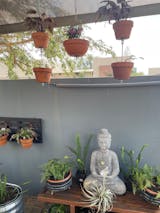
Green Gardening Hacks for a Thriving Garden
Green Gardening Hacks for a Thriving Garden offers the ultimate advice on what to do in your garden, so that you (and all the wonderful creatures that call it home) get the most out of it. Ready? Let’s get started.
Prune your dahlia for more blooms
For increased and bigger flowering the secret lies in pruning early and correctly.
You can do this by pinching out early growth. When dahlias reach 30–40cm high and have two or three pairs of leaves, remove the growing tip just above a healthy leaf set. This encourages the plant to produce more side shoots, resulting in bushier growth, stronger stems, and an abundance of flowers.
Disbud for bigger blooms: If you prefer fewer but larger flowers, remove the smaller buds that form behind the main central bloom. Limit each plant to 3–5 flowering stems to direct its energy into producing giant, show stopping blooms.
Deadheading keeps flowers coming
When removing spent blooms, don’t just snip off the flower—shorten the stem down to a new leaf or bud. This prevents the plant from wasting energy on dying flowers and redirects it into producing new buds instead.
This technique isn’t just for ornamentals—herbs like basil benefit too. Regularly pinching off flower buds stops the plant from going to seed too soon, extending its productive life and keeping the leaves tender and flavourful.
Pruning matters
Beyond encouraging more flowers, pruning improves airflow around plants, reducing moisture-related diseases. Proper cutting techniques can make your plants healthier, stronger, and more productive—whether they’re roses, dahlias, herbs, or shrubs.
So don’t be afraid to prune—your plants will thank you for it!

Bugs are good for the garden
Some plants naturally attract pests, drawing them away from the ones you want to protect. By planting these ‘decoys,’ you create a buffer zone in your garden. For example: Lily borers, which can devastate Hippeastrum and clivias, are first drawn to Crinum, which can better withstand their damage.
Aphids prefer roses over many other plants.
Cabbage white butterflies favour nasturtiums over cruciferous vegetables.
These plants not only help shield your favourites but also attract beneficial insects and pollinators.
Spend a penny to save many more
Rather than placing eggshells on soil, or sprinkling salt liberally around your garden to stop slugs and snails, use some old copper coins. Make cents nê? Glue them to the top edges of pots or place in a circle around your tender plants that are so attractive to the slimy ones. Copper repels these little chompers.
If you want birds in your garden, you gotta have bugs for them to eat. No bugs, no birds. Sometimes, you don’t want birds in your food garden! Instead of a scarecrow, try hanging old CDs or strips of VHS tape from branches or fences. While it might seem like birds love shiny things, the flashing reflections and movement make them feel threatened, encouraging them to stay away from your veggies. Simple, effective, and a great way to repurpose old items!
A weed is just a plant in the wrong place
Getting rid of weeds in paving is as easy as pouring boiling water onto them! Also, weed after it’s rained!
Need herbs in winter?
All too often we end up buying herbs out of season, many of which end up as interesting science projects in the bottom of our refrigerator vegetable drawers. Rather grow those fleshier herbs like basil and mint on your windowsill in water. Take a few cuttings and place in a bud vase of water. They should produce roots within a week or so. Keep changing the water regularly. Then just cut and come again!

Now where did I put that plant again?
When planting out bulbs or seeds, keep track of where they are by either putting little signs or pebbles there, or use a dark-coloured potting mix to cover them, which will make it obvious where the plants are going to start growing. This way you can work around them without fear of disturbing them. If your soil is naturally dark, take twig prunings or use old wooden chopsticks with string wrapped from one to the other to demarcate the area.
Be a bright bulb!
Plant your bulbs out at the right time. Don’t store them for a year and expect them to grow. All bulbs should come with a ‘best before’ date, like food does. Unless you know how to store bulbs properly, get them into the ground or into a container. Then, remember to water them and feed them while they still have leaves.
To test whether the bulb you’ve had hanging around is healthy or viable, pop them into a bucket of water. Healthy bulbs will sink. Floating ones should be thrown onto the compost heap.
Strapped for space?
Grow up. Vertical gardening has proven to be a staying ‘trend’. Hanging baskets, crates, pots, trellises, pergolas, walls, trees – make use of all vertical spaces.

Don’t dump your leaves!
Put the goodness back into your beds. Bare soil in a water-stressed country is a no-no. Rather than raking all leaves and other plant detritus up and tossing it into bags to go to landfill, rake them back into the beds. Unless they have fungus or other diseases, then toss them in the bin. That goes for rose leaves too.
Keeping it contained
Place sponges in the bottom of your indoor plant pots. This will save you time and keep your plants properly hydrated – and soak up overwatering.
There you have it, a pot-load of Green Gardening Hacks for a Thriving Garden this season and beyond. Happy gardening!


September
20 - 21,
2025





Leave a comment